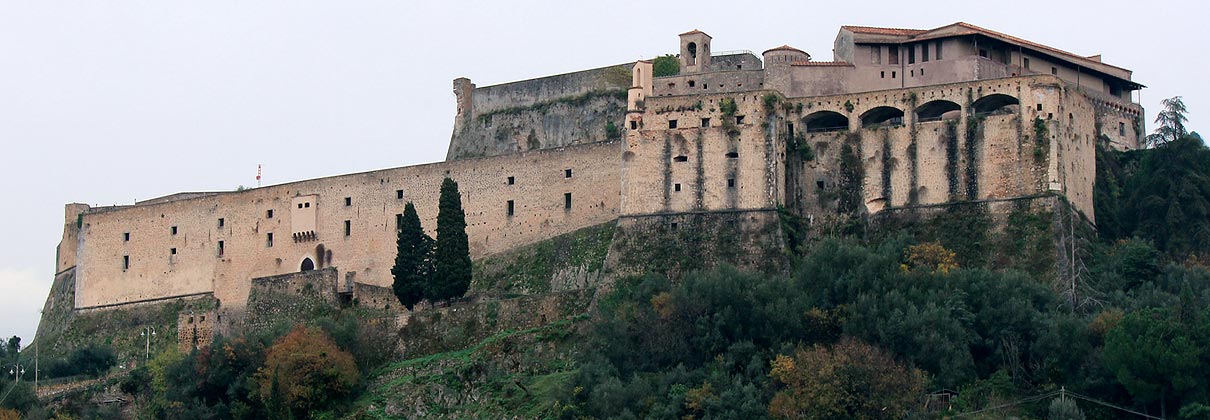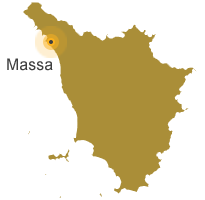
Massa
Things which make the town of Massa unique particularly welcoming are, without a doubt, the lovely structure of the territory and the resulting microclimate.
Indeed, Massa, on its northeast side, is surrounded by the Apuan Alps; instead, from the south-west side, it overlooks to the upper Tyrrhenian Sea; it takes only 30 minutes to go by car from Marina di Massa to Resceto (485 mt S.l.m.), a village situated next to Apuan Alps’s feet, whence some of the most beautiful mountain tracks lead to the top of the mountain.
The town is divided along the direction mountain-sea by the Frigido river; Borgo del Ponte, where the eponymous Tuscan holiday home is located, is perched on its left bank from the side of the city center and is crossed by a section of the Via Francigena.
Founded in pre-Roman times the first settlements were built along the river course, Massa is in fact mentioned for the first time as “ad tabernas Frigidas” in the “Tabula Peuntingeriana”, a table drawn up between the second and fourth centuries A.D. describing the itineraries of the time.
Between the XV and XIX century it was the capital of the independent principality, then Duchy of Massa and Carrara, possession before the Malaspina family and later the Cybo-Malaspina.
In 1829 the city passed to the Austrian Este Dukes of Modena before being annexed in 1859 to the Kingdom of Sardinia.
In 1871 it became the territory of the region of Tuscany.
In 1938 it was merged with the towns of Carrara and Montignoso, coming the new City of Apuania then suppressed in 1946.
Massa, on whose heights the trace of the Gothic Line perhaps still remains visible, is the Gold Medal for Civil Merit, conferred by President Carlo Azeglio Ciampi in 2006 for its efforts during the Liberation Struggle; the toll paid by the people of Massa and by partisans between 1944 and 1945 was considerable; the piercing sound of sirens during the allied bombing has come down to us, forever guarded by three hundred meters of tunnel carved into the rock of the Martana air-raid shelter.
Surrounded by rows of bright orange Piazza Aranci overlooks the historic city center, on whose northeast side, rises majestically Palazzo Ducale built by Alberico I Cybo-Malaspina.
On the large courtyard of the palace the beautiful porch, supported by columns of white marble from Carrara, overlooks.
Three huge halls, inside, keep frescoes depicting the glories of the past.
Downstairs a loggia encloses in semi-darkness the suggestive Grotesque “Il Ninfeo”, a representation of Neptune.
From Piazza Aranci, through a small stone path fraught, exceeding the Rocca, we lead up to the Castello Malaspina, an imposing fortress overlooking the city.
The castle, located in a strategic position, with a view reaching from the coast of Livorno to Bocca di Magra, in the course of its history, it was the subject of bitter disputes between Lucca, Florence, Pisa and the Visconti of Milan.
The Castello Malaspina is now the site of a food and wine event, the Spino Fiorito, and of the traditional fireworks show in the early summer.
Numerous restaurants are found in the historic center or on the hills around the town of Massa where you can enjoy an evening tasting the typical dishes of Massa: the tordelli (ravioli), the taglierini with beans, the trippa, the rooster or chicken with beards, the polenta, the marinated cod, the rabbit with sauce, all accompanied by the lively wines Candia Colli Apuani based on Vermentino, or precious Tuscan wines based on Sangiovese.
Dulcis in fundo, an explosion of taste: the rice cake, a cake traditionally made at Easter or for some Saints commemoration.
The Borgo del Ponte
The Borgo del Ponte, where the eponymous Tuscan home holidays is, whose distinguishing feature is the presence of ancient low houses, many of which are being restored, and narrow streets with open passages (the voltole) leading to internal courtyards and gardens most of which are citrus gardens.
Among the monuments of the village stand the seventeenth-century fountain in the square, the church of San Martino, the Porta Genovese leading to the stairs to the iron bridge over the river Frigido.
The Borgo takes its name from the medieval stone bridge with three arches, we can find also on the Palazzetto Andrei’s crests (now rectory’s site) and on the fountain; the bridge was destroyed at the end of the nineteenth century by a catastrophic flood of the river and then rebuilt in iron.
On summer evenings is very pleasant to stay, always carrying a pullover golf because of mountain air, getting some fresh air on the Porta Genovese square, or walking along the borough’s streets when the traffic is almost nonexistent.
In recent times the village was revitalized by public works of the main streets paving thanks to the project Via Francigena, and by the work of private subjects which, gathered in Association, are organizing various initiatives both cultural and entertainment.

